Linden D., Reddy T.B. (eds.) Handbook of batteries
Подождите немного. Документ загружается.

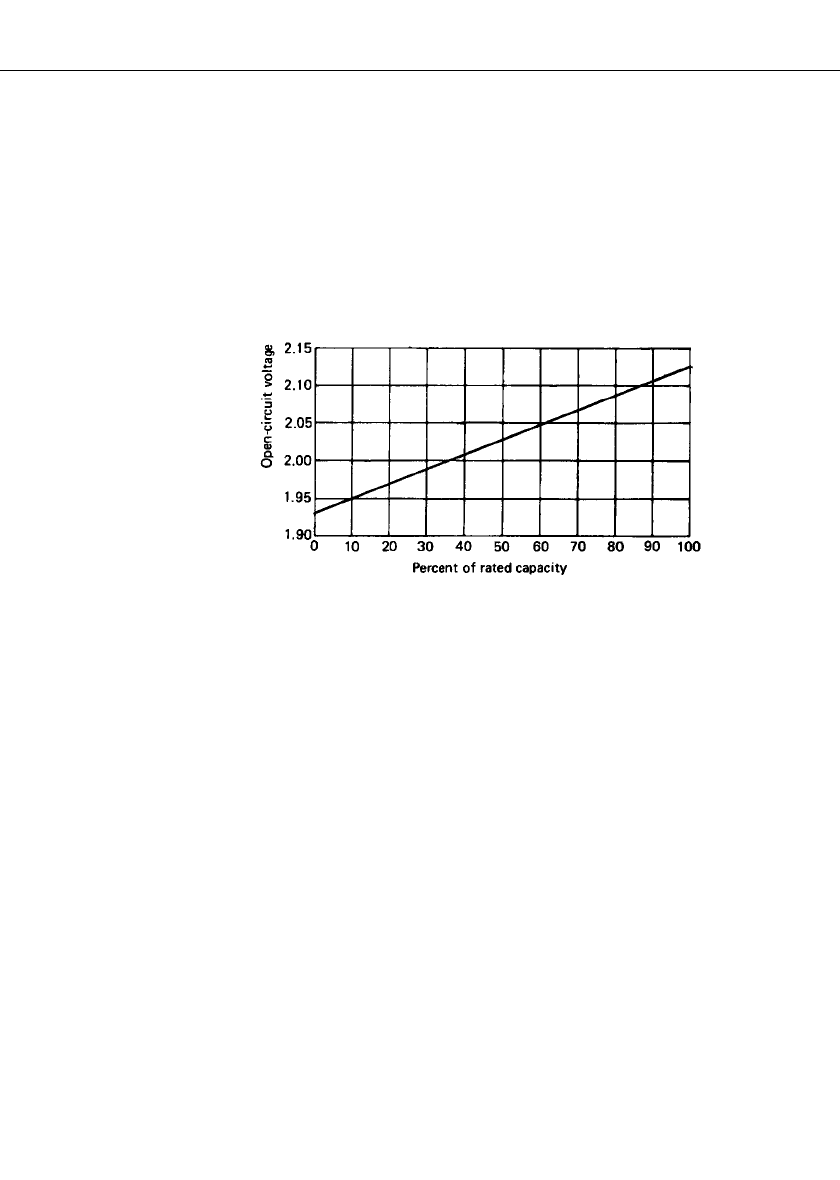
24.8 CHAPTER TWENTY-FOUR
24.4 PERFORMANCE CHARACTERISTICS
24.4.1 VRLA Cylindrical Cells
Voltage. The nominal voltage of a VRLA single-cell battery is 2.0 V, and it is typically
discharged to 1.75 V per cell under load. The open-circuit voltage depends on the state of
charge, as plotted in Fig. 24.6, based on a C /10 discharge rate. The open-circuit voltage can
therefore be used to approximate the state of charge. The curve is accurate to within 20%
if the battery has not been charged or discharged within 24 h; it is accurate to within 5% if
the battery has not been used for 5 days. The measurement of the open-circuit voltage to
determine the state of charge is based on the relationship between the electromotive force
(OCV) and the concentration of the sulfuric acid in the battery.
FIGURE 24.6 Open-circuit voltage vs. state of charge.
Discharge Characteristics. The discharge voltage profiles of typical VRLA single-cell bat-
teries, at various temperatures ranging from
⫺40 to 65⬚C for various discharge rates, are
shown in Fig. 24.7 (see Table 24.2 for capacity data on various size cells). The discharge
voltage curves are relatively flat at medium to low rates. These curves are based on smaller
2.5- and 5-Ah batteries. Discharge curves for the larger 25-Ah battery are slightly different
from those of the smaller batteries because of the greater distance from the center of the
plate to the external stud. This gives a higher effective internal impedance per unit of capacity
and results in a slightly lower performance at higher rates and lower temperatures. Figure
24.8 shows a set of discharge voltage curves for a 2.5-Ah cell at 25
⬚C, which further illus-
trates the good voltage performance of the cell even at high rates of discharge.
Effect of Temperature and Discharge Rate. The capacity of a VRLA battery, as with most
batteries, is dependent on the discharge rate and temperature, the capacity decreasing with
decreasing temperature and increasing discharge rate. The effect of temperature at the C/10,
C, and 5C rates is shown in Fig. 24.9 for the cylindrical type D and X for the batteries. The
larger 25-Ah cell gives a lower percentage of the 25
⬚C performance at lower temperatures
and higher discharge rates.
High-Rate Pulse Discharge. The VRLA battery is effective in applications which require
high-rate discharge, such as in engine-starting. The voltage-time curves for the battery at
room temperature at the 10C discharge rate, both on continuous discharge and for a 16.7%
duty cycle (10-s pulse, 50-s rest), are shown in Fig. 24.10 for 25 and
⫺20⬚C.
It is apparent from these data that the capacity of the VRLA battery is increased greatly
when an intermittent pulse discharge is used. This is true because of the phenomenon known
as ‘‘concentration polarization.’’ As a discharge current is drawn from the cell, the sulfuric
acid in the electrolyte reacts with the active materials in the electrodes. This reaction reduces
the concentration of the acid at the electrode-electrolyte interfaces. Consequently the cell
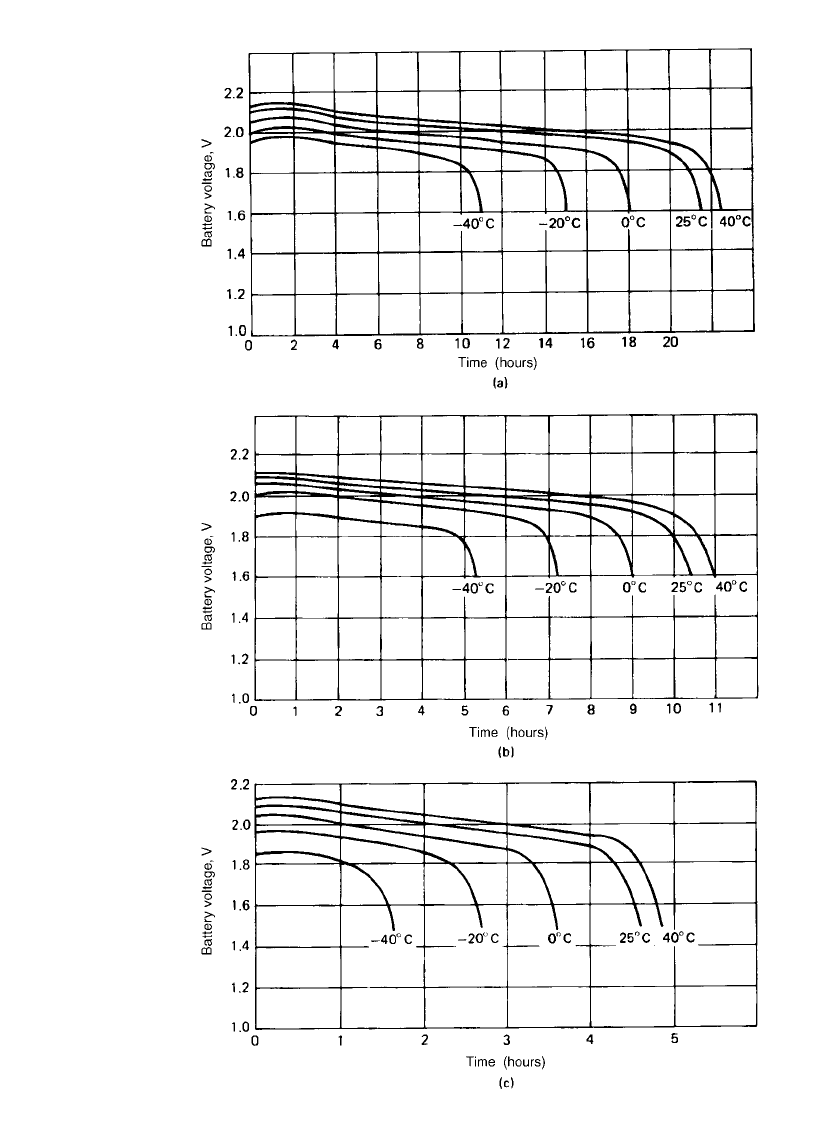
VALVE REGULATED LEAD-ACID BATTERIES 24.9
FIGURE 24.7 Discharge curves of cylindrical VRLA D and X single-cell batteries.
Discharge rate (a)atC / 20, (b)atC / 10, (c)atC /5.
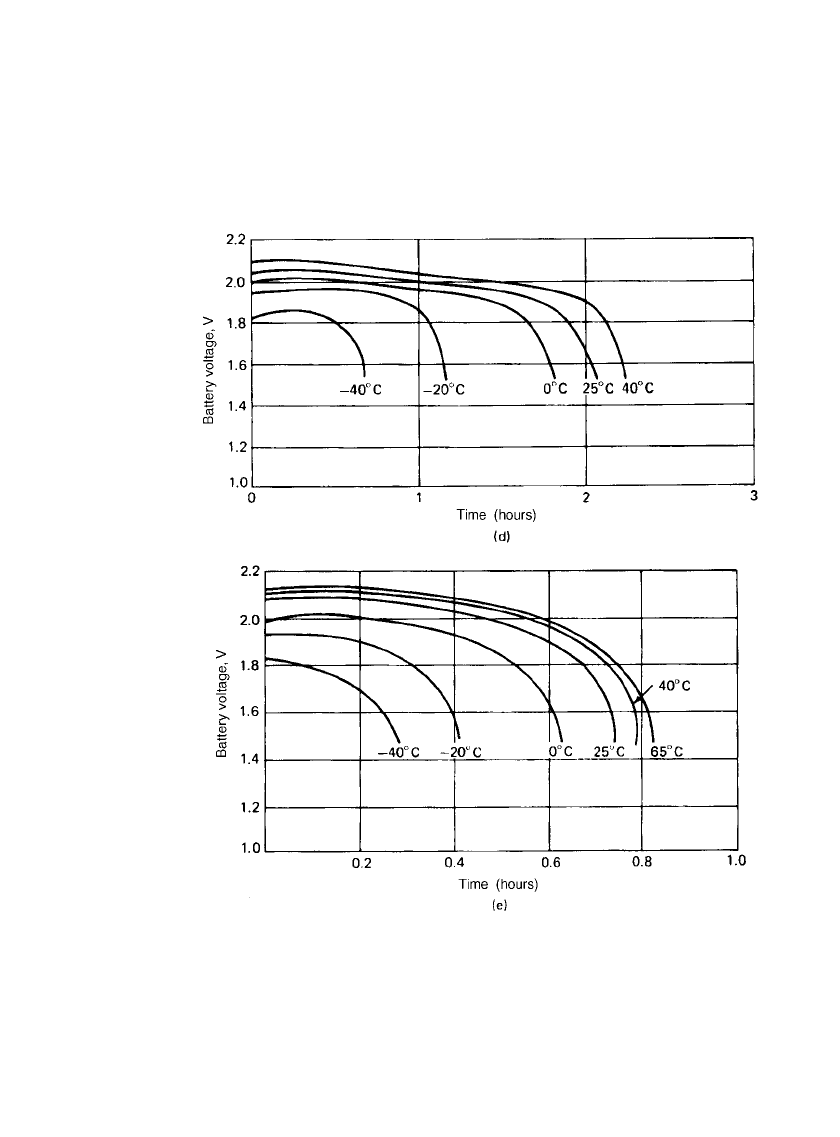
24.10 CHAPTER TWENTY-FOUR
FIGURE 24.7 (d )atC / 2.5, (e)at1C (see Table 24.2 for capacity data)
(Continued ).
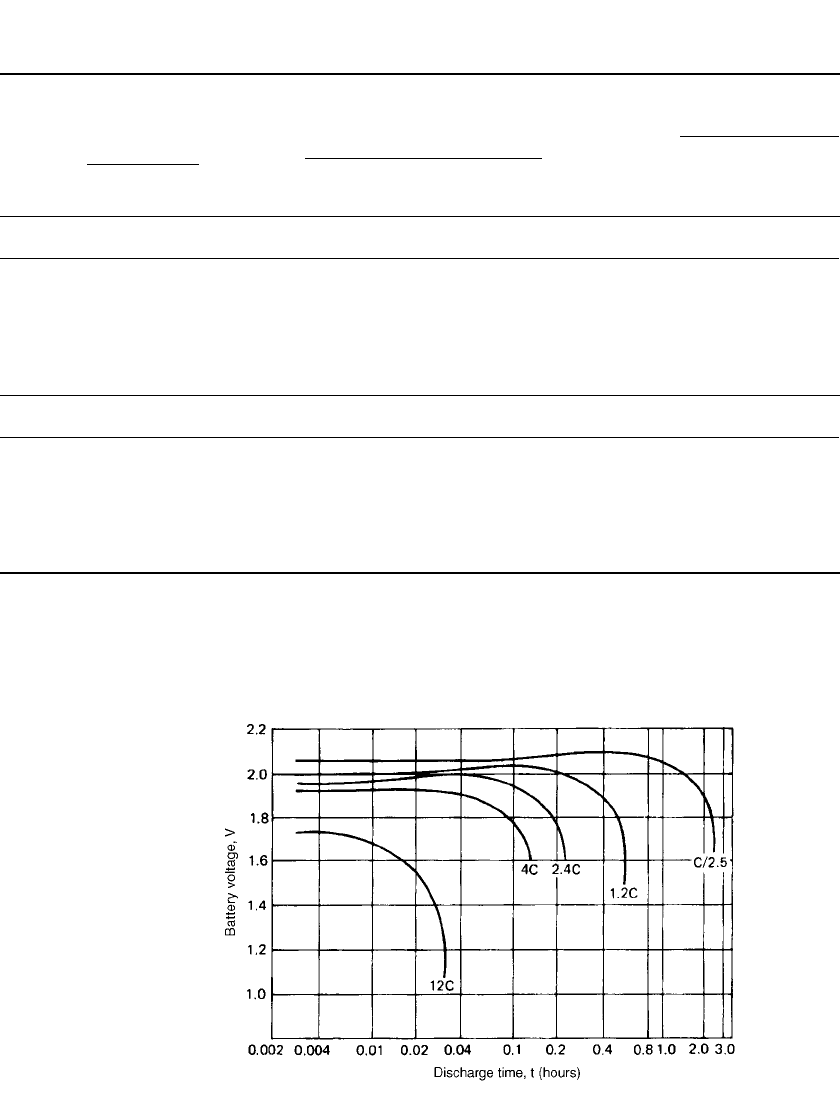
VALVE REGULATED LEAD-ACID BATTERIES 24.11
TABLE 24.2 VRLA Cylindrical Batteries
Model
Capacity, Ah
C /10 C /20 1C
Dimensions, mm
Height
Diameter,
width Length
Weight
(typical),
g
Specific energy
@C /20
Wh/kg
Maximum
discharge,
A
Single cells
D
X
J
BC
DT
E
2.5
5.0
12.5
25.0
4.5
8.1
2.7
5.4
13.0
26.0
4.8
8.4
1.8
3.2
9.0
17.5
3.7
6.2
67.3
80.3
135.7
172.3
102.9
108.7
34.3
49.5
51.8
65.3
34.3
44.5
N/A
N/A
N/A
N/A
N/A
N/A
180
390
840
1580
272
549
30.0
27.6
30.8
32.9
35.3
30.6
40
40
60
250
40
40
Monobloc batteries (preassembled batteries in common sizes)
D, 4 V
D, 6 V
X, 4 V
X, 6 V
E, 4 V
E, 6 V
2.5
2.5
5.0
5.0
8.0
8.0
2.7
2.7
5.4
5.4
8.6
8.6
1.8
1.8
3.2
3.2
5.8
5.8
70
70
77
77
102
102
45
45
54
54
54
54
78
113
96
139
96
139
360
540
740
1110
1110
1670
40
40
40
40
40
40
Source: Hawker Energy Products, Inc.
FIGURE 24.8 Discharge curves of VRLA cylindrical D and X batteries at
25⬚C, high discharge rates.
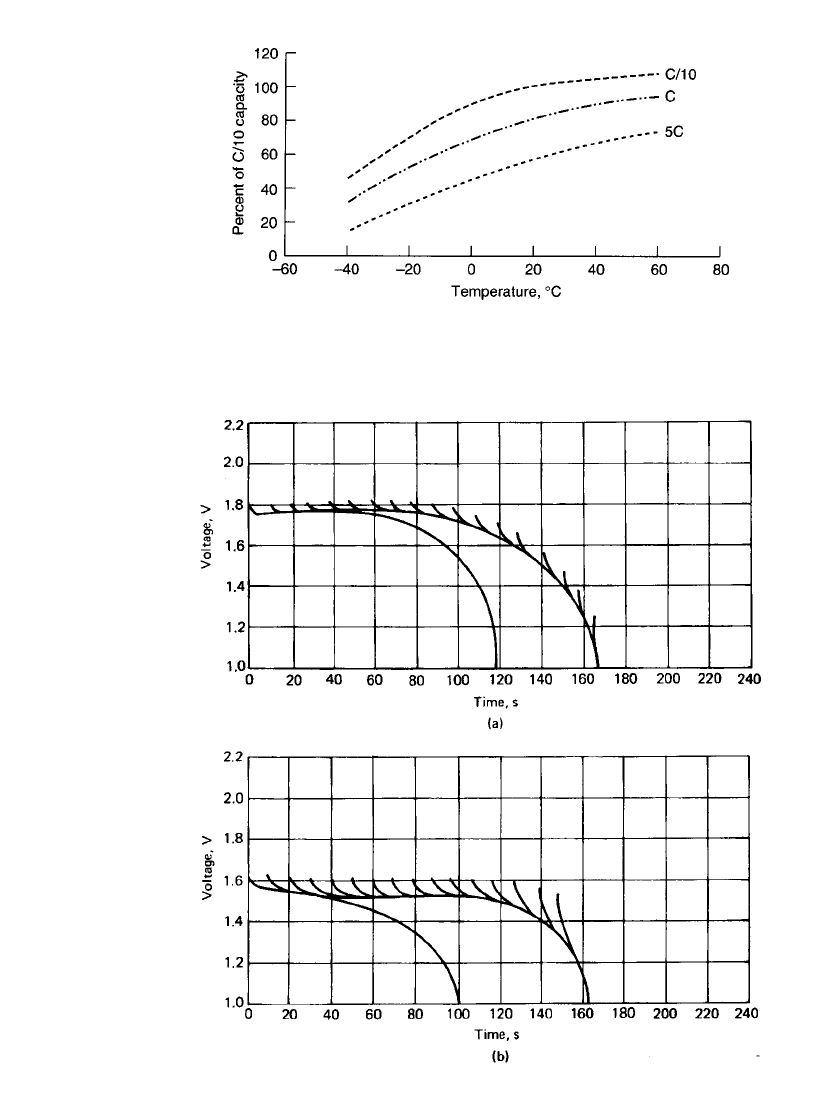
24.12 CHAPTER TWENTY-FOUR
FIGURE 24.9 Effect of temperature on capacity for D and X size cylin-
drical units.
FIGURE 24.10 High-rate pulse performance at 10C discharge rate for VRLA
cylindrical units. (a)25⬚C. (b) ⫺20⬚C. The upper curves are pulsed, the lower curves
are continuous discharges.

VALVE REGULATED LEAD-ACID BATTERIES 24.13
FIGURE 24.11 Effect of discharge rate on cell
midpoint voltage of VRLA batteries.
voltage drops. During the rest period, the acid in the bulk of the solution diffuses into the
electrode pores to replace the acid which has been used up. The cell voltage then increases
as acid equilibrium is established. During a pulse discharge the acid is allowed to equilibrate
between pulses, it is not depleted as quickly and the total cell capacity is increased.
The ability of the cell to provide high discharge currents and maintain usable voltage is
illustrated in Fig. 24.11. The effect of the discharge rate on the midpoint voltage is shown
at both 22 and
⫺20⬚C. (The voltage indicated was measured midway through the discharge.)
The curves in Fig. 24.12 illustrate the maximum power that can be delivered as a function
of the discharge rate at room temperature and at
⫺20⬚C. The maximum power obtainable
increases as the temperature increases.
Discharge Level. As with all rechargeable batteries, discharging the VRLA battery beyond
the point at which 100% of the capacity has been removed can shorten the life of the battery
or impair its ability to accept a charge.
The voltage point at which 100% of the usable capacity of the cell has been removed is
a function of the discharge rate, as shown in the upper envelope of the curve of Fig. 24.13.
The lower curve shows the minimum voltage level to which the battery may be discharged
with no effect on recharging capability. For optimum life and charge capability, the cell
should be disconnected from the load at the voltages within the gray area between the two
curves.
Under these ‘‘overdischarge’’ conditions, the sulfuric acid electrolyte can be depleted of
the sulfate ion and become mainly water, which can create several problems. A lack of
sulfate ions as charge conductors will cause the cell impedance to appear high and little
charge current to flow. Longer charge times or alteration of the charge voltage may be
required before normal charging may resume.
Another potential problem is the solubility of lead sulfate in water. In a severe deep-
discharge condition, the lead sulfate present at the plate surfaces can go into solution in the
aqueous electrolyte. Upon recharge, the water and the sulfate ion in the lead sulfate convert
to sulfuric acid, leaving a precipitate of lead metal in the separator. This lead metal can
result in dendritic short circuits between the plates and subsequently cell failure.
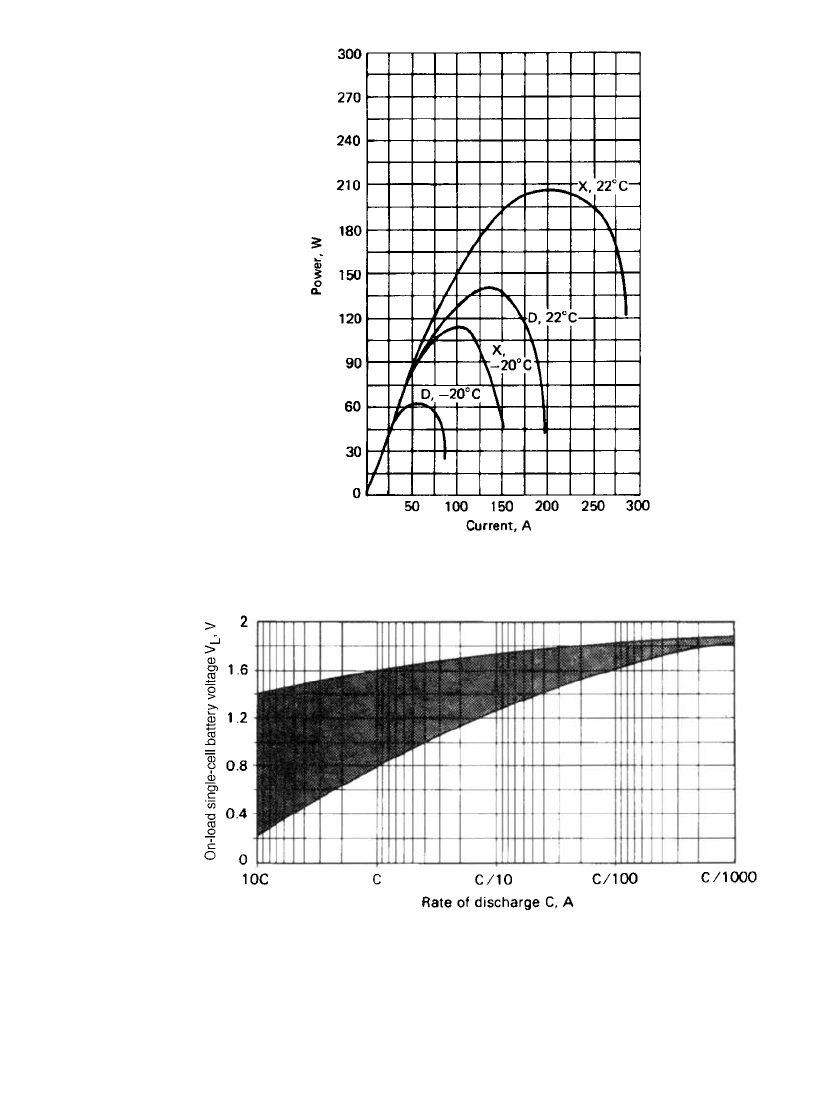
24.14 CHAPTER TWENTY-FOUR
FIGURE 24.12 Instantaneous maximum peak
power of VRLA batteries at 22 and ⫺20⬚C.
FIGURE 24.13 Acceptable voltage discharge levels of VRLA cells.
Storage Characteristics. Most batteries lose their stored energy when allowed to stand on
open circuit due to the fact that the active materials are in a thermodynamically unstable
state.
12
The rate of self-discharge is dependent on the chemistry of the system and the
temperature at which it is stored. The cylindrical VRLA battery is capable of long storage
without damage, as can be seen in Fig. 24.14, which plots the maximum storage time against
the storage temperature. This curve shows the maximum number of days at any given tem-
perature from 0 to 70
⬚C for the cell to self-discharge from 2.18 down to 1.81 V open circuit.
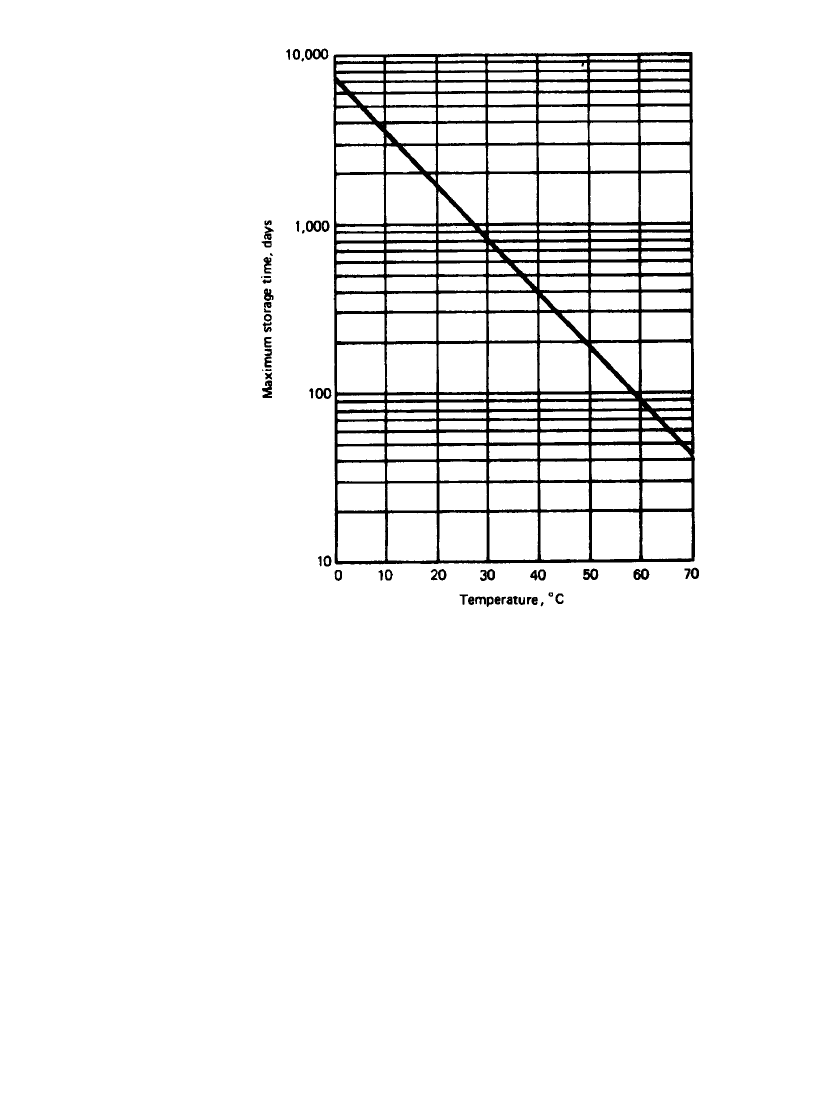
VALVE REGULATED LEAD-ACID BATTERIES 24.15
FIGURE 24.14 Storage characteristics of VRLA battery.
The cell should not be allowed to self-discharge below 1.76 V, because the recharge char-
acteristics of the cell change appreciably and the cycle life cannot be predicted accurately.
The capacity of these cells can be restored by recharging; however, the first charge on a cell
that has been allowed to self-discharge down to 1.76 V will take longer than normal, and
the first discharge will generally not deliver rated capacity. Subsequent cycles, however, will
show an increase in the cell capacity to rated value.
It is important to recognize that the self-discharge rate of the VRLA battery is nonlinear;
thus the rate of self-discharge changes as the state of charge of the cell changes. When the
cell is in a high state of charge, that is, 80% or greater, the self-discharge is very rapid. The
cell may discharge from 100 to 90% at room temperature in a matter of a week or two.
Conversely, at the same temperature it may take 10 weeks or longer for the same cell to
self-discharge from 20% state of charge down to 10% state of charge. Figure 24.15 is a
curve of open-circuit voltage versus percent remaining storage time, which shows the non-
linearity of the self-discharge reaction.
By the use of Figs. 24.14 and 24.15, the number of days of storage which remain before
a battery must be recharged can be calculated. As an example, if a battery has an open
circuit voltage of 2.00 V, the state of charge, as determined from Fig. 24.15, is 37%. From
Fig. 24.15 (again at an open-circuit voltage of 2.00 V), the remaining storage time is 82%.
Figure 24.16 shows that at 20
⬚C, the battery can be stored for a total of 1200 days before
it must be recharged. Therefore the remaining storage time is 82% of 1200 or 984 days.
This is the number of days at 2.00 V open-circuit voltage that a battery can be stored before
it will reach 1.76 V and must be recharged.
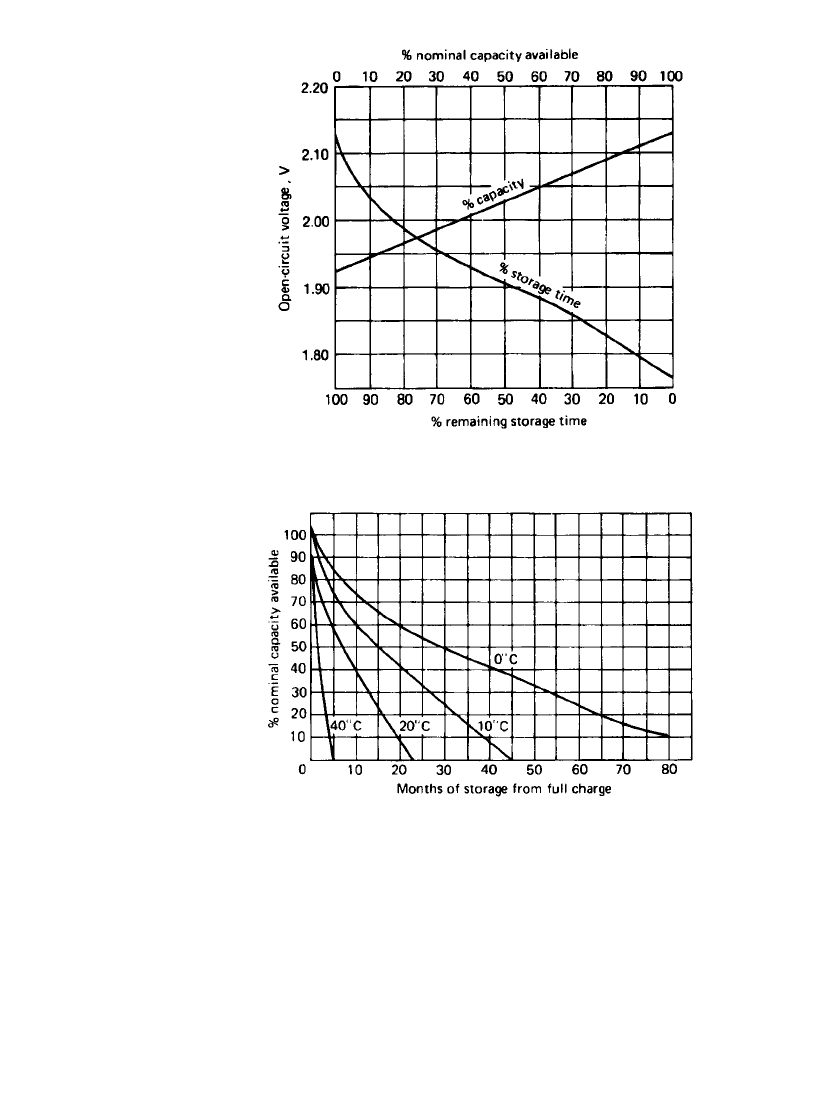
24.16 CHAPTER TWENTY-FOUR
FIGURE 24.15 Open-circuit voltage vs. percent remaining
storage time of VRLA batteries.
FIGURE 24.16 Remaining usable capacity of VRLA batteries
after storage.
Figure 24.16 is a curve of the remaining usable capacity in a VRLA battery versus months
of storage at various temperatures. This curve is convenient in determining the approximate
remaining capacity after a given storage time at a particular temperature.
Life. The life of all rechargeable battery systems is variable, depending on the type of use,
environment, cycling, and charge to which the battery is subjected during its life.
1. Cycle life: Figures 24.17 and 24.18 illustrate the effect of several of the factors which
control the cycle life. Figure 24.17 shows the effect of the charging voltage and demonstrates
the need to select the proper charging voltage for a particular cycle regime. The figure is
somewhat misleading, however, in that it would indicate that a low charging voltage, say
2.35 V, would yield a low cycle life, and this is not true. For example, for an application
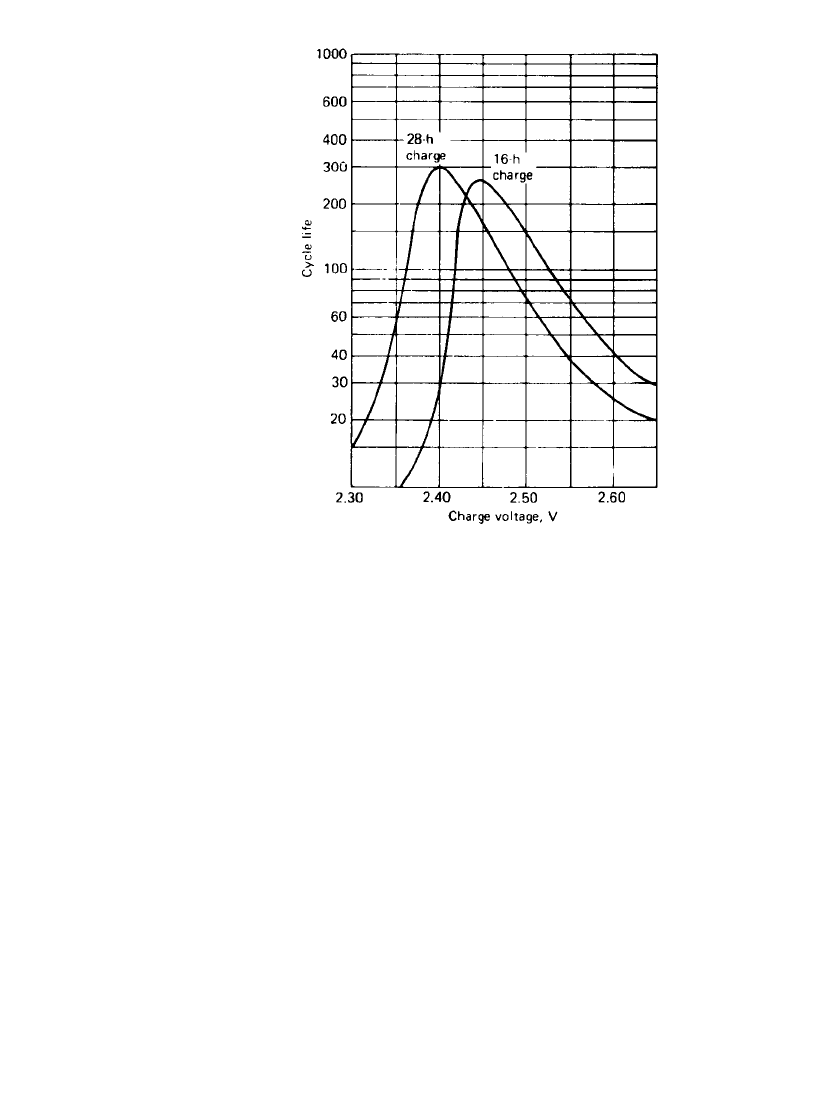
VALVE REGULATED LEAD-ACID BATTERIES 24.17
FIGURE 24.17 Effect of charge voltage on cycle life
of VRLA batteries at various charge times at 25⬚C and
approximately 100% DOD. End of cycle life—80% of
rated capacity; discharge rate—C/ 5 to 1.6 V.
where the cells would be used about three times a week and left on charge the rest of the
time, 2.35 V would be quite adequate. Most of the capacity can be returned to the cells
within 16 h. The occasional long charge periods would maintain capacity and thus optimize
the total cycle life. Generally, 2.45 V per cell is a better charging voltage for regimes of
about one cycle per day.
Figure 24.18 shows the general effect of the depth of discharge (DOD) on the cycle life;
typically at 100% DOD, 200 cycles are characteristic. It demonstrates that high cycle life
can be achieved by slightly oversizing the battery for the application to reduce the depth of
discharge. Figure 24.19 is a curve of capacity versus cycles for a 2.5-Ah cell (2.35 Ah at
5-h rate) cycled at 1 cycle per day at a C /5 discharge rate to 1.6 V per cell and an 18-h
charge at 2.5-V constant voltage. The cell takes from 20 to 25 cycles to achieve rated
capacity, exceeds rated capacity, and then begins to fall off slowly. The initial increase in
capacity is a function of forming the cell.
2. Float life: The expected float life of the VRLA battery is greater than 8 years at room
temperature, arrived at by using accelerated testing methods, specifically, at high tempera-
tures.
The primary failure mode of the VRLA battery can be defined as growth of the positive
plate. Because this growth is the result of chemical reactions within the cell, the rate of
growth increases with increasing temperature. In Fig. 24.20 the float life is plotted against
temperature. The solid lines represent data from float-life tests performed at two float volt-
ages, 2.3 and 2.4 V per cell. This graph can be used to determine the expected float life at
various temperatures. End of life is defined as the failure of the cell to deliver 80% of rated
capacity.
